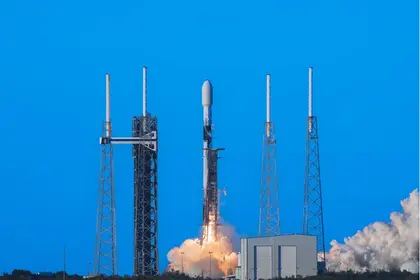The Pentagon announced on Wednesday the successful joint launch of six satellites by the Space Development Agency (SDA) and the Missile Defense Agency (MDA). The launch used a SpaceX Falcon 9 rocket to carry them into low-Earth orbit (LEO), about 1,200 miles above Earth’s surface.
Four of the satellites are the last of 27 launched since April 2023 as part of the SDA’s constellation of “Tranche 0” tracking layer satellites – eight for missile tracking and 19 for data transport and communications.
JOIN US ON TELEGRAM
Follow our coverage of the war on the @Kyivpost_official.
In September, the SDA will begin launching its “Tranche 1” versions, which will eventually include 161 operational satellites.
The other two orbiters are part of the MDA’s Hypersonic and Ballistic Tracking Space Sensor program (HBTSS). These sensors, designed and built by L3Harris Technologies and Northrup Grumman, will detect and track traditional ballistic missiles, maneuvering hypersonic weapons, and other advanced threats and send data directly to interceptors.
SDA Director Derek Tournear said in a Feb. 14 statement: “Launching our tracking satellites into the same orbit with the MDA HBTSS satellites is a win for both agencies. We’ll be able to look at test targets from the same orbit at the same time, so that we can see how the two sensors work together.”
The satellites are part of a wider plan to strengthen US missile warning and tracking capabilities to address increasing Chinese and Russian missile threats. Positioning the systems in the lower orbits allows them to operate using less complex sensors than those required by previous geosynchronous orbit (GEO) projects, situated about 22,000 miles above Earth.

French Policy Playing Into Iranian and Russian Hands
The budget for the project is likely to reach nearly $16 billion through to 2028. While these MDA and SDA test sensors were developed separately, future deployments will integrate the medium-field-of-view HBTSS sensor.
The systems will form part of the program of resilient layered network of military satellites and supporting elements known as the Proliferated Warfighter Space Architecture (PWSA) – an integrated proliferation of satellite constellations at different orbits and varying missions.
L3Harris built all four of the SDA satellites and one of HBTSS satellites, while Northrop Grumman built the other. It is the first time that L3Harris, an experienced satellite payload provider, has acted as a prime contractor for a satellite development program.
L3Harris CEO Christopher Kubasik said: “Our advanced satellites on orbit will bring the integrated and resilient missile warning and defense capabilities the US requires against adversaries developing more advanced maneuverable missiles. L3Harris delivered this advanced missile tracking capability on behalf of MDA and SDA on orbit in just over three years after work was authorized to proceed. We are proud to be a critical part of the new space sensing architecture.”
You can also highlight the text and press Ctrl + Enter






